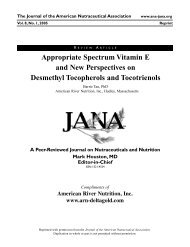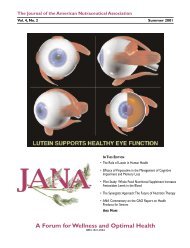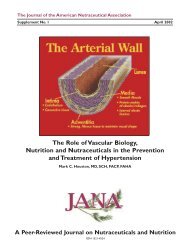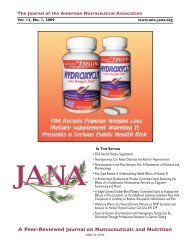JANA Vol 3 #1 - American Nutraceutical Association
JANA Vol 3 #1 - American Nutraceutical Association
JANA Vol 3 #1 - American Nutraceutical Association
You also want an ePaper? Increase the reach of your titles
YUMPU automatically turns print PDFs into web optimized ePapers that Google loves.
The Journal of the <strong>American</strong> <strong>Nutraceutical</strong> <strong>Association</strong><br />
<strong>Vol</strong>. 3, No. 1, Spring 2000 www.ana-jana.org Reprint<br />
R E V I E W A R T I C L E<br />
Use of <strong>Nutraceutical</strong>s in the<br />
Management of Osteoarthritis<br />
David Hungerford, MD, 1 Ronald Navarro, MD, 2 Tarek Hammad, MD, PhD, 3<br />
1 Head of Arthritis Division, Orthopedic Department, Johns Hopkins University, Baltimore, Maryland<br />
2 Orthopedic Surgeon, Kaiser Permanente, Harbor City, California<br />
3 Clinical Research Division, Nutramax Laboratories, Inc., Baltimore, Maryland<br />
A Peer-Reviewed Journal on <strong>Nutraceutical</strong>s and Nutrition<br />
Editor-in-Chief<br />
Mark Houston, M.D.<br />
ISSN-1521-4524<br />
Reprinted with permission from the Journal of the <strong>American</strong> <strong>Nutraceutical</strong> <strong>Association</strong>.<br />
Duplication in whole or part is not permitted without permission.
R E V I E W A R T I C L E<br />
Use of <strong>Nutraceutical</strong>s in the<br />
Management of Osteoarthritis<br />
David Hungerford, MD, 1 * Ronald Navarro, MD, 2 Tarek Hammad, MD, PhD, 3<br />
1<br />
Head of Arthritis Division, Orthopedic Department, Johns Hopkins University, Baltimore, Maryland<br />
2Orthopedic Surgeon, Kaiser Permanente, Harbor City, California<br />
3Clinical Research Division, Nutramax Laboratories, Inc., Baltimore, Maryland<br />
INTRODUCTION<br />
There are three types of joints in the body: fibrous,<br />
cartilaginous, and synovial. A synovial joint consists of<br />
bone, articular cartilage, joint capsule, ligaments, and a synovial<br />
membrane1 (Figure 1). Articular cartilage, a thin layer<br />
covering the opposing ends of the articulations, is comprised<br />
of 95% extracellular matrix, which is secreted and maintained<br />
by a few chondrocytes localized in lacunae. 2<br />
Composed of collagen fibers and proteoglycans, the matrix<br />
gives cartilage its tensile and compressive strength. Most<br />
proteoglycans in the cartilage are large aggregating complexes<br />
called aggrecans. They consist of hyaluronic acid and<br />
glycosaminoglycans, primarily chondroitin sulfate. 3,4<br />
Articular cartilage provides a smooth surface for<br />
bones to move against each other with minimal friction. Its<br />
aneural and avascular tissue allows the joint to withstand<br />
tremendous pressure without pain. Because of the lack of<br />
blood supply, lesions to articular cartilage do not heal as<br />
they do in other tissues. Loss of articular cartilage exposes<br />
richly innervated underlying bone, converting a painless<br />
joint to a painful one.<br />
OSTEOARTHRITIS<br />
Osteoarthritis (OA), also known as osteoarthrosis,<br />
degenerative joint disease, and degenerative arthritis, 5 is a<br />
heterogeneous group of disorders that result in articular cartilage<br />
degeneration. Considered the most common chronic<br />
* Correspondence:<br />
David Hungerford, MD<br />
Johns Hopkins Medicine, Dept. of Orthopedic Surgery<br />
Good Samaritan Professional Bldg.<br />
5601 Loch Raven Blvd. Baltimore, MD 21239<br />
Phone: 410-532-4732 Fax: 410-532-4752<br />
E-mail: dhunger@jhmi.edu<br />
Figure 1: cross section of a normal synovial joint<br />
joint disease, it is estimated that more than 21 million individuals<br />
in the United States have OA. 6<br />
The incidence of OA increases with age. Other risk<br />
factors are trauma to the joint earlier in life, fractures<br />
involving the joint surfaces, instability from ligament tears,<br />
and meniscal injuries that cause abnormal wear and tear of<br />
the joint. Postmenopausal women who are not taking estrogen<br />
replacement7 are also associated with increased risk of<br />
OA, as are those who have hyperglycemia, hypercholesterolemia,<br />
hypertension, 8 or a relevant hereditary factor. 9<br />
OA is an imbalance between synthesis and degradation<br />
occuring in the joints. 10 It is characterized by disturbance in<br />
the smooth property of the cartilage resulting in the formation<br />
of subchondral cysts and marginal osteophytes. 11<br />
Bone spurs may also form around the joint as the body’s<br />
Spring 2000 <strong>Vol</strong>. 3, No. 1 <strong>JANA</strong> 23
esponse. These processes continue until the full thickness<br />
of cartilage is lost, leaving the bone exposed.<br />
Diagnosis of OA is based on clinical and radiological<br />
findings. 10 The first clinical manifestations are pain, stiffness,<br />
swelling, crepitus, and restriction of joint movement. X-ray is<br />
an essential tool for diagnosing the severity of OA. 12<br />
Currently, the aim of OA treatment is to reduce pain<br />
and stiffness. Its management consists of pharmacologic<br />
and nonpharmacologic therapies. Pharmacologic treatment<br />
begins with acetaminophen, adding a low-dose nonsteroidal<br />
anti-inflammatory drug (NSAID), salicylate, selective<br />
COX-2 inhibitor, or topical capsaicin cream if needed.<br />
Analgesics or NSAIDs are the most common prescribed<br />
non-invasive treatment for reducing pain associated with<br />
early cases of OA. Pain reduction can also be achieved by<br />
non-pharmacological treatment. Physical therapy and<br />
decreasing the load on the joint through lifestyle changes<br />
such as weight loss and stress reduction can be challenging,<br />
but of great benefit. 13 In more severe cases, joint injections,<br />
irrigation, or arthroscopy may be beneficial. In patients who<br />
continue to have pain and limited function despite these<br />
measures, surgical intervention should be considered. 10<br />
Although NSAIDs have a definite effect in pain reduction,<br />
up to 20% of patients per year have severe gastrointestinal<br />
problems after prolonged intake. 14 A prophylactic<br />
drug such as a proton pump inhibitor or sucrulfate, or a<br />
cyclooxygenase 2-selective NSAID can be prescribed to<br />
decrease the risk of gastrointestinal complications. 15,16<br />
Long-term usage of some NSAIDs may inhibit synthesis of<br />
cartilage matrix. 17<br />
Drawbacks to the patient of long term use of NSAIDs<br />
have inspired researchers to investigate agents that have<br />
minimal or no side effects. Studies have been conducted on<br />
nutraceuticals such as chondroitin sulfate and glucosamine<br />
to demonstrate their efficacy in the symptomatic treatment<br />
of OA. Recent meta-analyses reviewed clinical trials of glucosamine<br />
and chondroitin in the treatment of osteoarthritis.<br />
Both showed substantial benefit in the treatment of<br />
osteoarthritis, although the clinical trials examined provided<br />
insufficient information about study design and conduct. 18-20<br />
GLUCOSAMINE<br />
The amino-monosaccharide glucosamine is a precursor<br />
of the disaccharide unit of glucosaminoglycan (GAG) and<br />
is reported to stimulate the production of proteoglycans, the<br />
ground substance of articular cartilage. 21,22 Glucosamine<br />
also stimulates synovial production of hyaluronic acid<br />
(HA), which is responsible for the lubricating and shockabsorbing<br />
properties of synovial fluid. 23<br />
Improvement in the symptoms of osteoarthritis associated<br />
with the use of glucosamine has been observed in several<br />
clinical trials. 24-26 Houpt et al. 27 conducted a recent<br />
24 <strong>JANA</strong> <strong>Vol</strong>. 3, No. 1<br />
double-blind study in Toronto, Canada, investigating the<br />
efficacy of the hydrochloride salt of glucosamine on pain<br />
and disability in knee OA. Although the primary endpoint,<br />
improvement in the pain score measured by the WOMAC<br />
questionnaire, was not met, a positive trend was noted for the<br />
glucosamine group. In addition, the secondary endpoint of<br />
cumulative pain reduction as measured by daily diary and<br />
knee examination was favorable, suggesting that glucosamine<br />
hydrochloride benefits some patients with knee OA.<br />
CHONDROITIN SULFATE<br />
Chondroitin sulfate is an important component of cartilage.<br />
The two types of chondroitin sulfate, chondroitin-4sulfate<br />
and chondroitin-6-sulfate, vary in molecular weight<br />
and thus differ in their bioavailability and purity. 28<br />
Chondroitin-4-sulfate is the most abundant GAG in growing<br />
mammalian hyaline cartilage. With age, chondrocytes<br />
secrete less chondroitin-4-sulfate and greater amounts of<br />
the other GAGs. This change has been observed in the initiation<br />
and progression of the degenerative process within<br />
the cartilage in OA. 29<br />
Omata et al. 30 injected bradykinin into the left knee<br />
articular cavities of rats 3 times a day for 2 days.<br />
Chondroitin sulfate was administered orally to rats for 14<br />
days and was shown to inhibit the bradykinin-induced proteoglycan<br />
depletion of the articular cartilage in a dosedependent<br />
manner. These results suggest that a reduction of<br />
the proteoglycan content of cartilage, the same process<br />
associated with osteoarthritis, can be inhibited by chondroitin<br />
sulfate.<br />
In another study chondroitin sulfate inhibited the<br />
aggrecanase enzyme in a dose-dependent manner, suggesting<br />
its protective effect. Aggrecanase has been believed to<br />
mediate aggrecans’ degradation in OA. 31 Several other<br />
studies reported similar inhibitory effects of chondroitin<br />
sulfate on many degradative enzymes. 32<br />
Because of the large molecular size of chondroitin sulfate,<br />
earlier reports voiced their concerns about its bioavailability.<br />
However, radiolabelled chondroitin sulfate given<br />
orally to humans was 70% absorbed. Its affinity for synovial<br />
fluid and articular cartilage has also been demonstrated.<br />
33 In addition, many clinical trials have documented the<br />
clinical efficacy of chondroitin sulfate in treating OA,<br />
showing significant symptomatic improvement and suggesting<br />
a structure-modifying effect. 34, 35<br />
COMBINED THERAPY<br />
From the previous sections it is evident that both chondroitin<br />
sulfate and glucosamine are effective in the treatment<br />
of osteoarthritis. Over the years the combined use of<br />
these nutraceuticals has become extremely popular. 13 Their<br />
use has fewer side effects than NSAIDs, and is the only<br />
Spring 2000
treatment suggested to prevent progression of the disease in<br />
preliminary reports. 34-36<br />
It is important to note that experimental studies have<br />
documented a synergistic effect when glucosamine and<br />
chondroitin sulfate are administered together. Lippiello et<br />
al. 37 reported that the co-administration of TRH122 low<br />
molecular weight sodium chondroitin-4-sulfate and<br />
FCHG49 glucosamine hydrochloride resulted in a greater<br />
increase of GAG production (96.6%) than for either agent<br />
alone (glucosamine, 32%; chondroitin, 32%). The same<br />
study showed that while chondroitin inhibited Interleukin-1,<br />
glucosamine did not. Therefore, neither is superior; each has<br />
a different mechanism of action. The body responds best<br />
when glucosamine and chondroitin sulfate are consumed<br />
simultaneously.<br />
In the same study, Lippiello et al. 37 investigated the<br />
efficacy of the same combination of nutraceuticals in modifying<br />
the cartilage in an OA model. Fifty percent of the<br />
rabbits were fed a regular diet while the rest were fed glucosamine<br />
and chondroitin sulfate in an amount equivalent<br />
to two percent of their body weight. At week 16, samples<br />
from the animals’ medial condyles were evaluated histologically.<br />
They concluded that the nutraceutical combination<br />
used in the study (Cosamin ®DS, Nutramax Laboratories)<br />
had a significant structure-modifying effect. (Figure 2). In<br />
addition, cartilage lesions were less severe in the combination<br />
therapy group in comparison to the individual components<br />
groups (Figure 3).<br />
Figure 2: Cartilage matrix in the intervention group<br />
(Cosamin ®DS)<br />
A B<br />
remained essentially intact (A), while in the<br />
placebo group (B) it was degraded.<br />
Figure 3: Extent of cartilage lesions as graded by Mankin’s<br />
score in various study groups.<br />
Two randomized, double-blind, placebo-controlled<br />
clinical trials investigated the efficacy of the same combination<br />
therapy in the management of OA. The first study<br />
was by Das and Hammad 38 who recruited 93 patients with<br />
knee OA. They found significant improvement in the treatment<br />
group of patients with mild or moderate knee OA at 4<br />
and 6 months, compared to controls (Figure 4). The second<br />
16-week crossover trial, conducted on 34 males from the<br />
U.S. Navy, showed that the same therapy combination<br />
relieves symptoms of knee OA. 39<br />
Figure 4: Significant functional improvement in the<br />
Cosamin ®DS group versus placebo.<br />
The scientific community, nevertheless, has expressed<br />
a high degree of skepticism towards nutraceuticals based in<br />
part on concerns about quality control and scientific testing<br />
of claims. <strong>Nutraceutical</strong>s are not FDA regulated; there is no<br />
requirement for rigorous scientific testing prior to marketing,<br />
there is no requirement of Good Manufacturing<br />
Practices (GMPs) to guarantee high quality and batch-tobatch<br />
consistency, and no validated method to analyze raw<br />
materials for purity. Consequently, studies have revealed<br />
that a number of preparations claiming to contain certain<br />
doses of glucosamine or chondroitin sulfate have significantly<br />
lower amounts (or none) of the dosages described. 20<br />
Therefore, it is not surprising to know that the Arthritis<br />
Foundation has recently recommended that “when a supplement<br />
has been studied with good results, find out which<br />
brand was used in the study, and buy that.” 40<br />
FUTURE APPLICATIONS<br />
It has been recently hypothesized that nutraceutical<br />
preparations may have benefit in patient populations different<br />
from the osteoarthritic group. In the field of sports<br />
medicine, athletes are always looking for an edge to avoid<br />
injury and, when injured, to recuperate quickly. Natural<br />
treatment preparations appeal to athletes, and many now<br />
Spring 2000 <strong>Vol</strong>. 3, No. 1 <strong>JANA</strong> 25
use nutraceuticals as an adjunct in their treatment regimens<br />
for aching joints.<br />
Theoretically, the use of nutraceuticals in sports medicine<br />
applications is appealing. In the areas of prophylaxis<br />
to avoid injury, initial treatment after injury to possibly<br />
avoid surgical intervention, and as an adjunct after surgical<br />
intervention, nutraceuticals are being added to the armamentarium<br />
of those who treat athletes predisposed to chondral<br />
and osteochondral injuries. In a recent placebo-controlled<br />
experimental study, pretreatment with a combination<br />
of glucosamine and chondroitin sulfate (Cosamin®DS)<br />
resulted in significantly less inflammation in the intervention<br />
group. 41 In another pretreatment study using the same<br />
combination, there was a significantly lower incidence and<br />
severity of arthritis. 42<br />
Chondral wear and injury can occur during long runs<br />
and workouts, and many distance runners suffer occasional<br />
bouts of effusions in the knees and ankles. Use of nutraceuticals<br />
before long runs and routinely during a season of<br />
training may reduce the incidence of effusions, leading to<br />
less training days lost to swollen joints. Many runners train<br />
by building up mileage, and days lost to injury mean lessened<br />
readiness for an event.<br />
Contact and cutting sports can lead to chondral and<br />
osteochondral injuries, primarily seen in conjunction with<br />
ligamentous injury. Whether the injuries are clinically diagnosed<br />
or first seen on magnetic resonance imaging, treatment<br />
has been difficult due to the avascular nature of articular<br />
cartilage. Recent use of nutraceutical preparations in this<br />
application is supported by animal studies where treatment<br />
of acute (chemically induced and surgical instability) chondral<br />
injuries with nutraceuticals had beneficial, structuremodifying<br />
effects. 37,41-44 When patients are treated surgically<br />
with osteochodral pinning or grafting, it follows that postsurgical<br />
application of nutraceuticals may also be of benefit.<br />
Meniscal tears are common in weekend and professional<br />
athletes alike. <strong>Nutraceutical</strong> preparations that<br />
enhance meniscal healing, especially after surgical repair,<br />
are sure to be developed as the meniscus is the main protector<br />
of the knee joint.<br />
Future use of nutraceuticals in these areas is exciting<br />
and opens an opportunity for extensive study of efficacy.<br />
REFERENCES:<br />
1. Anderson MA. Oral Chondroprotective Agents. Part I,<br />
Compendium on Continuing Education, 21:7, July 1999.<br />
2. Mankind HJ, Johnson ME, Lippiello L. Biochemical and<br />
metabolic abnormalities in articular cartilage from<br />
osteoarthritic human hips II, correlation of morphology<br />
and biochemical and metabolic data. J Bone Joint Surg<br />
1971;53:523.<br />
26 <strong>JANA</strong> <strong>Vol</strong>. 3, No. 1<br />
3. Clark DM. The biochemistry of degenerative joint disease<br />
and its treatment. Comp Cont Ed Pract<br />
1991;13:275-281.<br />
4. Palmer JL, Bertone AL. Joint structure, biochemistry and<br />
biochemical disequillibrium in synovitis and equine<br />
joint disease. Equine Vet J 1994;26:263-277.<br />
5. Felson DT. Epidemiology of hip and knee osteoarthritis.<br />
Epidemiologic Reviews 1988;10:1-27.<br />
6. Lawrence RC, Helmick CG, Arnett FC. Estimates of the<br />
prevalence of arthritis and selected musculoskeletal disorders<br />
in the United States. Arthritis Rheum 1998;<br />
41(5): 778-799.<br />
7. Felson DT, Zhang Y. An update on the epidemiology of<br />
knee and hip osteoarthritis with a view to prevention.<br />
Arthritis Rheum 1998;41(8):1343-1355.<br />
8. Hart DJ, Doyle DV, Spector TD. <strong>Association</strong> between<br />
metabolic factors and knee osteoarthritis in women. The<br />
Chingford study. J Rheumat 1995;22(6):1118-1123.<br />
9. Cooper C, McAlindon T, Snow S, Vines K, Young P,<br />
Kirwan J, Dieppe P. Mechanical and constitutional risk<br />
factors for symptomatic knee osteoarthritis: differences<br />
between medial tibiofemoral and patellofemoral disease.<br />
J Rheumat 1994;21(2):307-313.<br />
10. Rehman Q, Lane NE. Getting control of osteoarthritis<br />
pain: an update on treatment options. Postgrad Med<br />
Oct 1, 1999;106(4):127-134.<br />
11. Buckwalter JA, Lane NE. Athletics and osteoarthritis.<br />
Am J Sports Med Nov-Dec 1997;25(6):873-81.<br />
12. Kellgren JH, Lawrence JS. Radiological assessment of<br />
osteoarthritis. Ann Rheum Dis 1957;16:494-501.<br />
13. Hungerford DS. Treating osteoarthritis with chondroprotective<br />
agents. Orthopedic Special Edition<br />
1998;1:39-42.<br />
14. Schoenfeld P, Kimmey MB, Scheiman J, Bjorkman D,<br />
Laine L. Nonsteroidal anti-inflammatory drug-associated<br />
gastrointestinal complications--guidelines for prevention<br />
and treatment. Aliment Pharmacol Ther Oct<br />
1999;13(10):1273-1285.<br />
15. Hirschowitz BI. Minimizing the risk of NSAIDinduced<br />
GI bleeding. Cleve Clin J Med Oct 1999;<br />
66(9):524-527.<br />
16 . Plosker GL, Lamb HM. Diclofenac/misoprostol: pharmacoeconomic<br />
implications of therapy. Pharmacoeconomics<br />
Jul 1999;16(1):85-98.<br />
17. Brandt K. Nonsteroidal anti-inflammatory drugs and<br />
articular cartilage. J Rheumat 1987;14(suppl):132-133.<br />
18. McAlindon TE, LaValley MP, Gulin JP, Felson DT.<br />
Glucosamine and chondroitin treatment for osteoarthritis.<br />
A systematic quality assessment and meta-analysis.<br />
JAMA 2000;283,1469-1475.<br />
Spring 2000
19. Barclay TS, Tsourounis C, McCart GM. Glucosamine.<br />
Ann Pharmacother May 1998; 32(5):574-579.<br />
20. Deal CL, Moskowitz RW. <strong>Nutraceutical</strong>s as therapeutic<br />
agents in osteoarthritis. The role of glucosamine, chondroitin<br />
sulfate, and collagen hydrolysate. Rheum Dis<br />
Clin North Am May 1999; 25(2):379-395.<br />
21.Burkhardt D, Gosh P. Laboratory evaluation of<br />
antiarthritic drugs as potential chondroprotective agents.<br />
Seminars in Arthritis and Rheumatism 1987; 17:3-34.<br />
22.Hellio MP, Vigron E, Annefeld M. The effects of glucosamine<br />
on the human osteoarthritis chondrocytes, in<br />
vitro investigations. Proc 9th Eular Syp 1996;11-12.<br />
23.McCarty MF. Enhanced synovial production of<br />
hyaluronic acid may explain rapid clinical response to<br />
high-dose glucosamine in osteoarthritis. Med<br />
Hypotheses Jun 1998; 50(6):507-510.<br />
24.Reichelt A. Forster KK, Fischer M, Rovati LC, Setnikar<br />
I. Efficacy and safety of intramuscular glucosamine sulfate<br />
in osteoarthritis of the knee. Arzneimittelforschung<br />
1994; 44(1):75-80.<br />
25.Drovanti A, Bignamini AA, Rovati AL. Therapeutic<br />
activity of oral glucosamine sulfate in osteoarthritis: a<br />
placebo-controlled double-blind investigation. Clin<br />
Ther 1980; 3:260-272.<br />
26.Vaz AL. Double-blind clinical evaluation of the relative<br />
efficacy of ibuprofen and glucosamine sulphate in the<br />
management of osteoarthrosis of the knee in outpatients.<br />
Curr Med Res Opin 1982; 8:145-149.<br />
27.Houpt JB, McMillan R, Wein C, Paget-Dellio SD. Effect<br />
of glucosamine hydrochloride in the treatment of pain of<br />
osteoarthritis of the knee. J Rheumat Nov<br />
1999;26(11):2423-30.<br />
28.Das A. Treatment of osteoarthritis with chondroprotective<br />
agents. Orthop Special Ed 5 1999; 1-4.<br />
29.Ronca G. Anti-inflammatory activity of chondroitin sulfate.<br />
Proc 3rd Int Cong Osteoathr Res Soc 1997; 2.<br />
30.Omata T, Segawa Y, Itokazu Y, Inoue N, Tanaka Y.<br />
Effects of chondroitin sulfate-C on bradykinin-induced<br />
proteoglycan depletion in rats. Arzneimittelforschung<br />
Jul 1999; 49(7):577-581.<br />
31.Sugimoto K, Takahashi M, Yamamoto Y, Shimada K,<br />
Tanzawa K. Identification of aggrecanase activity in<br />
medium of cartilage culture. J Biochem (Tokyo) Aug<br />
1999; 126(2):449-455.<br />
32.Paroli E, Antonilli L, Biffoni M. Pharmacological<br />
approach to glycosaminoglycans. Drugs Exp Clin Res<br />
1991;8:9-20.<br />
33.Conte A, <strong>Vol</strong>pi N, Palmiera L, Bahous I, Ronca G.<br />
Biochemical and pharmacokinetic aspects of oral treatment<br />
with chondroitin sulfate. Drug Res 1995; 45: 918-<br />
925.<br />
34.Uebelhart D, Thonar EJ, Delmas PD, Chantraine A,<br />
Vignon E. Effects of oral chondroitin sulfate on the progression<br />
of knee osteoarthritis: a pilot study.<br />
Osteoarthritis Cartilage 1998;6(suppl A):39-46.<br />
35.Verbruggen G, Goemaere S, Veys EM. Chondroitin sulfate:<br />
S/DMOAD (structure/disease modifying antiosteoarthritis<br />
drug) in the treatment of finger joint<br />
osteoarthritis. Osteoarthritis Cartilage 1998;6(suppl<br />
A):36-38.<br />
36.Fillmore CM, Bartoli L, Bach R, Park Y. Nutrition and<br />
dietary supplements. Phys Med Rehabil Clin N Am Aug<br />
1999;10(3):673-703.<br />
37.Lippiello L, Woodward J, Karpman R, Hammad TA.<br />
Beneficial effect of cartilage structure modifying agents<br />
tested in chondrocyte cultures and a rabbit instability<br />
model of osteoarthrosis. Arthritis and Rheumatism<br />
1999; 42(suppl):S256.<br />
38.Das AK, Hammad T, Eitel J. Efficacy of a combination<br />
of glucosamine hydrochloride, sodium chondroitin sulfate<br />
and manganese ascorbate in the management of<br />
knee osteoarthritis: a randomized double-blind placebocontrolled<br />
clinical trial. Paper <strong>#1</strong>80, 66th Annual<br />
Meeting, <strong>American</strong> Academy of Orthopedic Surgeons,<br />
Anaheim, Calif, Feb 6, 1999. Accepted for publication<br />
in Osteoarthritis Cartilage.<br />
39.Leffler CT, Philippi AF, Leffler SG, Mosure JC, Kim<br />
PD. Glucosamine, chondroitin, and manganese ascorbate<br />
for degenerative joint disease of the knee or low<br />
back. Mil Med Feb 1999;164(2):85-91.<br />
40.Horstman J. Arthritis Foundation’s Guide to Alternative<br />
Therapies. Atlanta, Arthritis Foundation, 1999.<br />
41.Canapp SO, McLaughlin Jr. RM, Hoskinson JJ, Rough<br />
JK, Butine MD. Scintigraphic evaluation of dogs with<br />
acute synovitis after treatment with glucosamine<br />
hydrochloride and chondroitin sulfate. AJVR 1999;<br />
60:1550-1556.<br />
42.Beren J, Hill SL, Rose NR. “Therapeutic Effect of<br />
Cosamin ® on Autoimmune Type II Collagen-Induced<br />
Arthritis in Rats.” Presented at the 1997 North<br />
<strong>American</strong> Veterinary Conference (Proceedings of<br />
Innovations and New Product Applications in<br />
Veterinary Practice). Jan: 35. Accepted for publication<br />
in the Proceedings of the Society for Experimental<br />
Biology and Medicine 2000.<br />
43.Personal Communication Terry Clyburn, MD. The<br />
University of Texas Houston Health Center.<br />
44.Uebelhart D, Eugene J, Thonar A, Zhang J, et al.<br />
Protective effect of exogenous chondroitin 4,6 sulfate in<br />
the acute degredation of articular cartilage in the rabbit.<br />
Osteoarthritis Cartilage 1998; 6 (suppl A):6-13.<br />
Spring 2000 <strong>Vol</strong>. 3, No. 1 <strong>JANA</strong> 27









